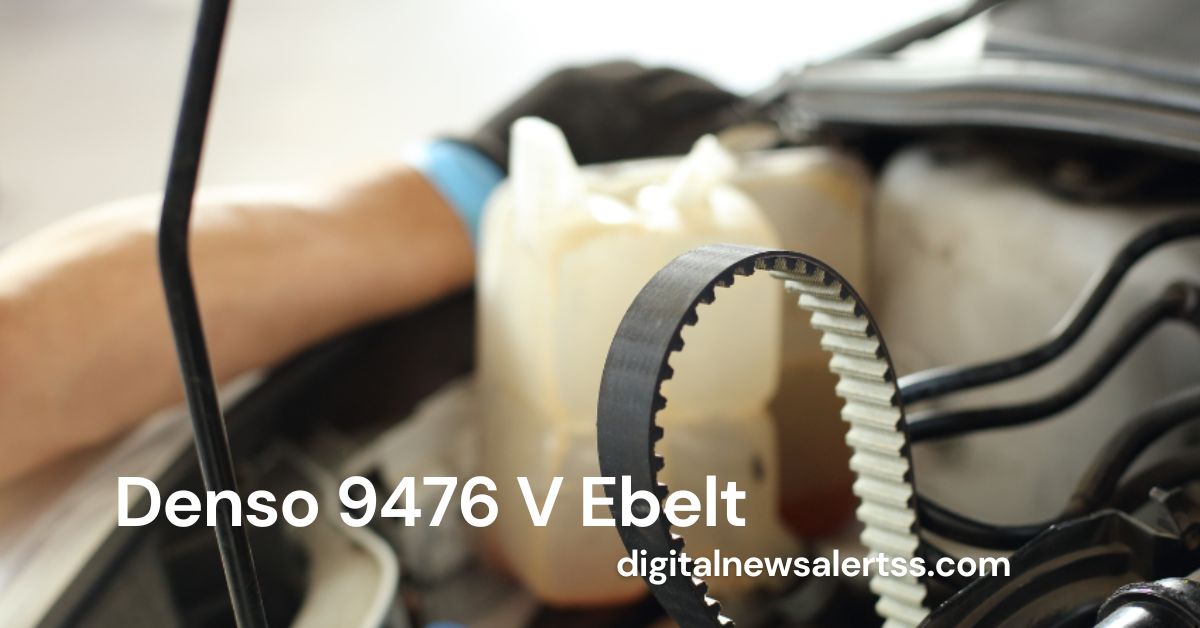Is your car’s engine not running as smoothly as it used to? Are you hearing strange noises from under the hood? It might be time to consider upgrading your vehicle’s V-belt. And when it comes to quality V-belts, the Denso 9476 stands out from the pack. This comprehensive guide will explore everything you need to know about the Denso 9476 V Ebelt – from its key features and benefits to installation tips and maintenance advice.
What is a V-Belt and Why is it Important?
Before we dive into the specifics of the Denso 9476 V Ebelt, let’s cover some basics. A V-belt, also known as a drive belt, is a crucial component in your vehicle’s engine. It’s responsible for transferring power from the engine’s crankshaft to various accessories like the alternator, power steering pump, air conditioning compressor, and water pump.
The V-belt gets its name from its trapezoidal cross-section, which resembles the letter “V”. This unique shape allows it to fit snugly into the grooved pulleys of the engine components it drives. A properly functioning V-belt ensures that all these vital parts work together efficiently, keeping your engine running smoothly.
Introducing the Denso 9476 V Ebelt
Now that we understand the importance of V-belts in general, let’s focus on the star of our show – the Denso 9476 V Ebelt. Denso is a well-known name in the automotive parts industry, renowned for producing high-quality, reliable components. The 9476 V-belt is no exception to this reputation.
Key Features of the Denso 9476 V Ebelt
- Premium Construction: The Denso 9476 V Ebelt is made from top-grade materials, ensuring durability and longevity.
- Precise Fit: Engineered to exact specifications, this belt offers a perfect fit for compatible vehicles.
- Noise Reduction: The belt’s design minimizes noise and vibration during operation.
- Heat Resistance: Built to withstand high temperatures, reducing the risk of premature wear.
- Flexibility: The belt maintains optimal flexibility, allowing for smooth power transfer.
Benefits of Upgrading to the Denso 9476 V Ebelt
Improved Engine Performance By upgrading to the Denso 9476 V Ebelt, you’re likely to notice an immediate improvement in your engine’s performance. The belt’s superior construction allows for more efficient power transfer between components, resulting in smoother engine operation.
Enhanced Fuel Efficiency A properly functioning V-belt can contribute to better fuel efficiency. The Denso 9476’s precise fit and low-friction design mean less energy is wasted in powering your engine’s accessories, potentially leading to savings at the pump.
Reduced Maintenance Costs Thanks to its durable construction, the Denso 9476 V Ebelt typically lasts longer than standard V-belts. This means fewer replacements over time, saving you money on parts and labor costs.
Quieter Engine Operation If you’ve been dealing with annoying squeals or chirps from your engine, upgrading to the Denso 9476 V Ebelt could provide welcome relief. Its noise-reducing design helps create a quieter, more pleasant driving experience.
Increased Reliability With its heat-resistant properties and robust construction, the Denso 9476 V Ebelt is less likely to fail unexpectedly. This increased reliability can give you peace of mind, especially on long trips or in challenging driving conditions.
Is the Denso 9476 V Ebelt Right for Your Vehicle?
While the Denso 9476 V Ebelt offers numerous benefits, it’s essential to ensure it’s compatible with your specific vehicle make and model. Here are some steps to determine if this V-belt is right for you:
- Check your vehicle’s manual: Look for information about the recommended V-belt specifications.
- Consult a professional: A certified mechanic can advise you on whether the Denso 9476 is suitable for your car.
- Use online resources: Many auto parts websites have tools to check part compatibility based on your vehicle’s details.
- Measure your current belt: If you’re replacing an existing V-belt, measure its length and width to ensure the Denso 9476 is a suitable replacement.
Installing the Denso 9476 V Ebelt: A Step-by-Step Guide
If you’re handy with car maintenance, you might consider installing the Denso 9476 V Ebelt yourself. Here’s a general guide to help you through the process:
Safety First: Always ensure your engine is cool and the battery is disconnected before beginning any work.
Step 1: Locate the current V-belt Consult your vehicle’s manual to find the exact location of the V-belt.
Step 2: Release belt tension Most vehicles have an automatic tensioner. Use a wrench to rotate the tensioner and release the old belt.
Step 3: Remove the old belt Carefully slide the old belt off the pulleys.
Step 4: Compare the old and new belts Ensure the Denso 9476 V Ebelt matches the length and width of your old belt.
Step 5: Install the new Denso 9476 V Ebelt Route the new belt around the pulleys following the same path as the old belt.
Step 6: Re-tension the belt Use the tensioner to apply the correct amount of tension to the new belt.
Step 7: Double-check installation Ensure the belt is properly seated in all pulleys and has the correct tension.
Step 8: Test run Start your engine and listen for any unusual noises. If everything sounds smooth, you’ve successfully installed your new Denso 9476 V Ebelt!
Remember, if you’re not confident in your ability to replace the V-belt safely, it’s always best to seek professional help.
Maintaining Your Denso 9476 V Ebelt
To get the most out of your Denso 9476 V Ebelt and ensure it continues to perform optimally, regular maintenance is key. Here are some tips to keep your V-belt in top shape:
- Regular Inspections: Check your V-belt visually every few months or during routine oil changes. Look for signs of wear, cracks, or fraying.
- Keep it Clean: Regularly clean the belt and pulleys to prevent buildup of dirt and debris that can cause premature wear.
- Proper Tension: Ensure the belt maintains proper tension. A belt that’s too loose can slip, while one that’s too tight can cause excessive wear.
- Alignment Check: Make sure all pulleys remain properly aligned to prevent uneven wear on the belt.
- Avoid Contamination: Keep oil and other fluids away from the belt, as these can cause deterioration.
- Replace When Necessary: Even the best V-belts eventually wear out. Be prepared to replace your Denso 9476 V Ebelt when signs of significant wear appear.
Troubleshooting Common V-Belt Issues
Even with a high-quality product like the Denso 9476 V Ebelt, issues can occasionally arise. Here are some common problems and their potential solutions:
Squealing Noise If you hear a high-pitched squeal, especially when starting your car or during sharp turns, it could indicate a loose belt. Check the tension and adjust if necessary.
Chirping Sound A rhythmic chirping noise might suggest that the belt is misaligned or one of the pulleys is damaged. Inspect the system and realign or replace components as needed.
Glazing If the belt appears shiny or glazed, it may be slipping. This can be caused by oil contamination or improper tension. Clean the belt and pulleys, and adjust the tension.
Cracking Small cracks across the width of the belt are a sign of age and indicate that replacement is needed soon.
Fraying If the edges of the belt are frayed or chunks are missing, replace the belt immediately to prevent sudden failure.
The Environmental Impact of Quality V-Belts
In today’s world, environmental considerations are increasingly important. While it might not be obvious at first glance, using a high-quality V-belt like the Denso 9476 can actually have positive environmental impacts:
- Improved Fuel Efficiency: As mentioned earlier, a well-functioning V-belt can contribute to better fuel economy. This means less fuel consumption and lower emissions over time.
- Reduced Waste: Because the Denso 9476 V Ebelt is built to last longer than standard belts, it results in fewer replacements. This means less waste in landfills from discarded belts.
- Efficient Manufacturing: Denso is known for its commitment to efficient manufacturing processes, which can result in lower environmental impact during production.
- Optimal Engine Performance: By keeping your engine running smoothly, the Denso 9476 V Ebelt helps maintain your vehicle’s designed emission levels.
While these impacts might seem small on an individual level, when multiplied across millions of vehicles, the positive environmental effects can be significant.
The Future of V-Belt Technology
As automotive technology continues to evolve, so too does V-belt design. While the Denso 9476 V Ebelt represents the current pinnacle of V-belt technology, it’s interesting to consider what the future might hold:
- Smart Belts: Future V-belts might incorporate sensors to provide real-time data on belt condition and performance.
- Self-Adjusting Tension: Advanced materials and design could lead to belts that automatically maintain optimal tension.
- Extended Lifespan: Ongoing research into new materials could result in V-belts with even longer lifespans.
- Eco-Friendly Materials: As sustainability becomes increasingly important, we may see V-belts made from recycled or biodegradable materials.
- Integration with Electric Vehicles: As more vehicles transition to electric power, V-belt design will likely adapt to meet the unique needs of these systems.
While these advancements are speculative, they highlight the ongoing importance of V-belt technology in automotive engineering.
Comparing the Denso 9476 V Ebelt to Competitors
While the Denso 9476 V Ebelt is an excellent product, it’s always wise to consider how it stacks up against the competition. Here’s a brief comparison with some other popular V-belt brands:
- Gates V-Belts: Known for their durability, Gates belts are a strong competitor. However, some users report that the Denso 9476 offers smoother operation.
- Continental V-Belts: Continental produces high-quality belts, but the Denso 9476 often edges them out in terms of noise reduction.
- Dayco V-Belts: Dayco belts are competitively priced, but may not match the longevity of the Denso 9476.
- Goodyear V-Belts: Another respected brand, Goodyear belts perform well but some users find the Denso 9476 to be more resistant to heat and wear.
Remember, the best choice can vary depending on your specific vehicle and driving conditions. Always consult with a professional if you’re unsure.
Conclusion: Is the Denso 9476 V Ebelt Worth It?
After exploring the various aspects of the Denso 9476 V Ebelt, from its key features and benefits to installation and maintenance, it’s clear that this is a high-quality product that can significantly improve your vehicle’s performance. Its durable construction, precise fit, and noise-reducing properties make it a standout choice in the world of V-belts.
While it may come at a slightly higher price point than some competitors, the potential benefits in terms of improved engine performance, enhanced fuel efficiency, and reduced maintenance costs make it a worthwhile investment for many vehicle owners.
Remember, a V-belt is a critical component in your engine’s operation. Choosing a reliable, high-performance option like the Denso 9476 V Ebelt can provide peace of mind and potentially save you money in the long run by reducing the frequency of replacements and helping to maintain your engine’s efficiency.
As with any automotive decision, it’s important to consider your specific needs and consult with a professional if you’re unsure. But for many drivers looking to optimize their vehicle’s performance, the Denso 9476 V Ebelt represents an excellent choice that combines quality, durability, and performance in one package.
Frequently Asked Questions (FAQs)
How often should I replace my Denso 9476 V Ebelt?
While the Denso 9476 V Ebelt is built for longevity, replacement intervals can vary based on driving conditions and vehicle use. Generally, it’s recommended to inspect your V-belt every 60,000 miles or as specified in your vehicle’s manual.
Can I use the Denso 9476 V Ebelt in any vehicle?
The Denso 9476 V Ebelt is designed to fit a wide range of vehicles, but it’s crucial to check compatibility with your specific make and model before purchasing.
How do I know if my V-belt needs replacement?
Signs that your V-belt may need replacement include visible wear or cracks, unusual noises from the engine area, and decreased performance of belt-driven accessories.
Is it difficult to install the Denso 9476 V Ebelt myself?
While it’s possible for experienced DIYers to install the belt, it requires some mechanical knowledge and proper tools. If you’re unsure, it’s best to have a professional mechanic handle the installation.
Will using the Denso 9476 V Ebelt void my vehicle’s warranty?
Generally, using aftermarket parts like the Denso 9476 V Ebelt shouldn’t void your warranty, especially if it meets or exceeds OEM specifications. However, it’s always best to check your warranty terms or consult with your dealer.
Can the Denso 9476 V Ebelt improve my car’s fuel efficiency?
While not guaranteed, a properly functioning V-belt can contribute to better overall engine efficiency, which may lead to improved fuel economy.
Is the Denso 9476 V Ebelt more expensive than other brands?
The Denso 9476 V Ebelt may be priced slightly higher than some competitors, but many users find the additional cost justified by its performance and durability.
How long does the Denso 9476 V Ebelt typically last?
While lifespan can vary based on driving conditions and vehicle use, many users report that the Denso 9476 V Ebelt lasts longer than standard V-belts, often exceeding 100,000 miles.
Can I use the Denso 9476 V Ebelt in extreme weather conditions?
Yes, the Denso 9476 V Ebelt is designed to withstand a wide range of temperatures and weather conditions, making it suitable for use in both very hot and very cold climates.
Where can I purchase a Denso 9476 V Ebelt?
The Denso 9476 V Ebelt is available at many auto parts stores, both online and brick-and-mortar. You can also find it through authorized Denso distributors or some car dealerships.



